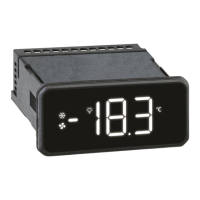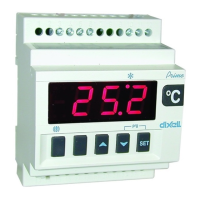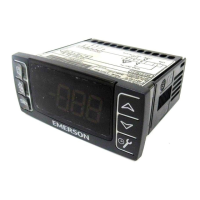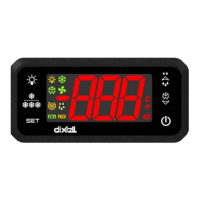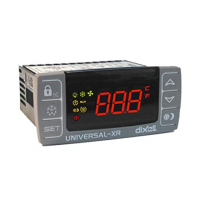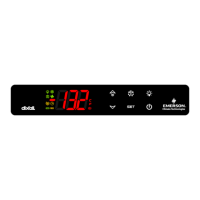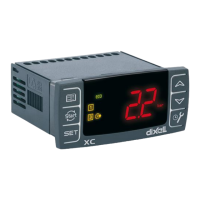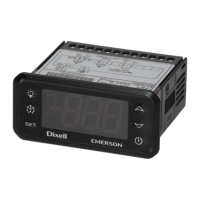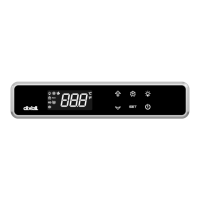1592009630 XW570K GB r1.0 04.08.2015 XW570K 4/6
8. ANALOGUE OUTPUT 4÷20 mA (OPTIONAL)
The analogue output is obtained through a 420mA signal proportional to the input selected in parameter
“CAO”. Through the analogue output the speed of fans can be regulated according to the input variable.
The following input types can be selected through the “CAO” parameter:
“CAO” = P1 room temperature
“CAO” = P2 evaporator temperature
“CAO” = P3 third probe temperature
“CAO” = 1r2 room temperature - evaporator temperature
To adjust the analogue output the following parameters are available:
“AOS” = Start point for analogue output
“APb” = Band width for analogue output can be either positive (direct action) and negative (inverse
action).
Named T the input, the relationship input-output is given by the following charts
NOTE: When the defrost is in progress, the analogue output is set to the minimum value (4 mA). This condition
lasts until the defrost terminates.
9. INSTALLATION AND MOUNTING
T850 keyboards shall be mounted on vertical panel, in a 150x31 mm hole, and fixed using two screws
3 x
2mm. To obtain an IP65 protection grade use the front panel rubber gasket (mod. RG-L). Power modules
XW570K shall be mounted in a panel with two or more screws and they must be connected to the keyboards by
means of a two-wire cable ( 1mm). The temperature range allowed for correct operation is 0 - 60 °C. Avoid
places subject to strong vibrations, corrosive gases, excessive dirt or humidity. The same recommendations
apply to probes. Let the air circulate by the cooling holes.
9.1 T850 - CUT OUT
165
150
31
+0.5
-0
+0.5
-0
+1
-1
Ø3 x2
9.2 MOUNTING WITH KEYBOARD COVER OPENING DOWNWARD
9.3 MOUNTING WITH KEYBOARD COVER OPENING UPWARD
10. ELECTRICAL CONNECTIONS
XW570K are provided with screw terminal block to connect cables with a cross section up to 2,5 mm
2
for the
RS485(optional) and the keyboard. Connecting other inputs, power supply and relays, XW570K are provided
with Faston connection (6,3mm). Heat-resistant cables have to be used. Before connecting cables make sure
the power supply complies with the instrument’s requirements. Separate the probe cables from the power supply
cables, from the outputs and the power connections. Do not exceed the maximum current allowed on each
relay, in case of heavier loads use a suitable external relay.
N.B. Maximum current allowed for all the loads is 20A.
10.1 PROBE CONNECTIONS
The probes shall be mounted with the bulb upwards to prevent damages due to casual liquid infiltration. It is
recommended to place the thermostat probe away from air streams to correctly measure the average room
temperature. Place the defrost termination probe among the evaporator fins in the coldest place, where most ice
is formed, far from heaters or from the warmest place during defrost, to prevent premature defrost termination.
11. TTL/RS485 SERIAL LINE
The TTL connector allows, by means of the external module TTL/RS485 (XJ485), to connect the unit to a
network line ModBUS-RTU compatible as the Dixell monitoring system XJ500 (Version 3.0).
The same TTL connector is used to upload and download the parameter list of the “HOT KEY“. The instruments
can be ordered wit the serial output RS485(Optional).
12. USE OF THE PROGRAMMING “HOT KEY “
The Wing units can UPLOAD or DOWNLOAD the parameter list from its own E2 internal memory to the “Hot
Key” and vice-versa.
12.1 DOWNLOAD (FROM THE “HOT KEY” TO THE INSTRUMENT)
1. Turn OFF the instrument by means of the ON/OFF key, remove the TTL serial cable if present, insert the
“Hot Key” and then turn the Wing ON.
2. Automatically the parameter list of the “Hot Key” is downloaded into the Wing memory, the “DoL”
message is blinking. After 10 seconds the instrument will restart working with the new parameters.
3. Turn OFF the instrument remove the “Hot Key”, plug in the TTL serial cable, then turn it ON again.
At the end of the data transfer phase the instrument displays the following messages:
“end “ for right programming.
The instrument starts regularly with the new programming.
“err” for failed programming.
In this case turn the unit off and then on if you want to restart the download again or remove the “Hot
key” to abort the operation.
12.2 UPLOAD (FROM THE INSTRUMENT TO THE “HOT KEY”)
1. Turn OFF the instrument by means of the ON/OFF key and remove the TTL serial cable if present; then
turn it ON again.
2. When the Wing unit is ON, insert the “Hot key” and push è key; the "uPL" message appears.
3. Push “SET” key to start the UPLOAD; the “uPL” message is blinking.
4. Turn OFF the instrument remove the “Hot Key”, plug in the TTL serial cable, then turn it ON again.
At the end of the data transfer phase the instrument displays the following messages:
“end “ for right programming.
“err” for failed programming. In this case push “SET” key if you want to restart the programming again
or remove the not programmed “Hot key”.
13. ALARM SIGNALS
Alarm output ON; Compressor output according
to “COn” and “COF”
Alarm output ON; Other outputs unchanged
Alarm output ON; Other outputs unchanged
Maximum temperature alarm
Alarm output ON; Other outputs unchanged
Minimum temperature alarm
Alarm output ON; Other outputs unchanged
Alarm output ON; Other outputs unchanged
Alarm output ON; Other outputs unchanged
Alarm output ON; Other outputs unchanged
Alarm output ON; Other outputs OFF
Alarm output ON; Other outputs OFF
Alarm output ON; Other outputs unchanged; Defrosts according to par.
“IdF”
The alarm message is displayed until the alarm condition is recovery.
All the alarm messages are showed alternating with the room temperature except for the “P1” which is flashing.
To reset the “EE” alarm and restart the normal functioning press any key, the “rSt” message is displayed for
about 3s.
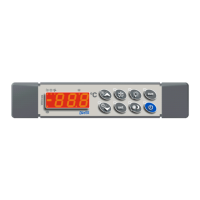
